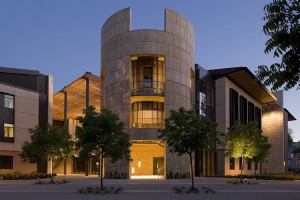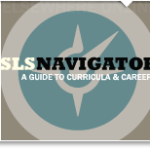Stanford Law School Advances New Model for Legal Education

STANFORD, Calif., February 13, 2012—Stanford Law School today announced the completion of the first phase of comprehensive reforms to its legal curriculum that began in November 2006—successfully transforming its traditional law degree into a multi-dimensional JD, which combines the study of other disciplines with team-oriented, problem-solving techniques together with expanded clinical training that enables students to represent clients and litigate cases while in law school.
Stanford Law School’s JD program preserves the essential components of a rich, traditional legal curriculum while leveraging the rest of Stanford University to enable law students to understand their future clients’ needs through courses and joint degree programs coordinated with Stanford’s other top-rated graduate programs and departments. Students also develop sophisticated problem-solving skills through multi-disciplinary project courses, which present real-world business and policy problems, and they are exposed to professional practice through full-time work in a clinic that offers experience in a wide range of practice areas—from Supreme Court litigation to corporate transactional law.

“What we’re doing here no other law school has done,” said Larry Kramer, Richard E. Lang Professor of Law and Dean, “and no other law school can do, because no other university matches Stanford in the number of top-notch programs and departments relevant to lawyers. We’ve utilized the whole university to create a multi-dimensional legal education, because we think lawyers have a valuable role to play in helping to solve the world’s problems and that calls for more than knowing how to analyze case law. And we think we are uniquely positioned among law schools to produce lawyers who do that.”
Background
Business, medicine, government, education, science, and technology have all grown immensely more specialized, and legal practice has had to adapt by growing more specialized too. And, while traditional legal education does a wonderful job teaching lawyers how to spot problems, it does not teach them how to solve them. To do this, especially in a world where the problems have grown more intricate, lawyers need to understand what their clients do at a much more sophisticated level than can be taught through the traditional law school curriculum or in the traditional law school classroom.
At the same time, lawyers today practice in a global context, across national borders. As recently as a generation ago, a graduate of Stanford Law School might spend his or her entire career without encountering foreign or international law or handling a transaction across national boundaries. Today, the opposite is true. Today’s law graduates enter a world in which almost nothing stops at the borders between nations. International trade and tribunals, human rights and intellectual property, business deals and war crimes—there is a pervasive global dimension to the work of lawyers, judges, and legal scholars.
“At Skadden, we value innovation tremendously, and Stanford Law School’s curriculum reforms reflect a truly forward-looking holistic approach to legal education,” said Howard L. Ellin, global hiring partner at Skadden, Arps, Slate, Meagher & Flom LLP & Affiliates. “The law school is dedicated to anticipating and fulfilling the practical and intellectual needs of both its students and the legal and business communities they enter after graduation.”
“In order to contribute to solutions,” explained Dean Kramer, “lawyers must be able to work collaboratively as part of cross-disciplinary professional teams. They have to be able to think like their client, a way of thinking that can and should begin in law school, and they should learn how to operate in a global context.”
“In rethinking our curriculum,” Kramer continued, “we recognized that we could lay the foundation of traditional legal analysis in the first year while enriching and enlarging our students’ experience by modifying their opportunities in the second and third years—making better use of their time in school to ready them for the role they can and should play in practice and in society.”
Concrete changes:
- Since 2006, Stanford Law School has successfully revamped its course offerings, modified its academic calendar from semesters to quarters to integrate with the rest of Stanford University, and broadened the joint degree option. It offers 23 formal joint degree programs and 28 individual joint degrees (including two with outside institutions). At the same time, the law school continues to allow students to tailor their own joint degree program in almost any discipline. The number of law students enrolled in joint degree programs has increased ninefold over the past six years. As an indicator of strong student interest, law students have now registered for more than 600 classes outside the law school each year—a twentyfold increase from six years ago—and non-law student registrations for courses at the law school have grown by a similar amount.
- The law school has developed a range of sophisticated team-oriented, problem-solving courses that are co-taught by faculty from the law school and Stanford’s other top-rated schools. Examples include courses on how to bring an invention to market (evaluating the technology, drafting a business plan, protecting intellectual property, and managing the regulatory process), how to engineer a complex business deal, how to translate complex scientific concepts into a courtroom or policymaking setting, and how to develop technology solutions to legal problems.
- The law school greatly expanded its clinical education program: it reorganized the clinics so they operate as a single law firm, The Mills Legal Clinic; it increased the number of clinics to ten, broadening the range of practice areas of clinics (including practice in international law); and introduced a clinical rotation—based on the medical school model—with no competing exams or courses. In 2010, 65 percent of the second and third year students took a clinic.
- The law school expanded the international dimension of its curriculum to emphasize international business, trade, and tax, as well as national security, integrating this new emphasis with the traditional public international law curriculum. The school added a third LLM program, International Economic Law, Business and Policy, and expanded the size of its existing programs so that international students now make up 15 percent of the upper-level student body. These students hail from all over the world and are already established in their home countries as highly qualified attorneys and policymakers. Not only are JD students and advanced degree international students able to learn from each other, together they’ve forged a truly international community of emerging leaders in the law.
- In addition, the law school developed a wide variety of new programs to give law students direct experience of studying and working in a global setting. These include study abroad and student exchange programs, enlarged opportunities for externships and summer jobs abroad, an international clinic, and law and development programs that have students doing work in countries around the globe (including Afghanistan, Bhutan, Timor Leste, and Iraq).
- The law school enlarged and modified student and faculty research opportunities through the launch of a dozen new research centers and programs, in areas as diverse as constitutional and criminal law, energy, corporate governance, the legal profession, and more. As part of this process, students have been afforded new opportunities to work on important public policy problems for government and other agencies, such as how to implement California’s Public Safety Realignment Act.
- To inculcate the important values of public service and community responsibility inevery Stanford law student, the school launched the John and Terry Levin Center for Public Service and Public Interest Law, which offers future lawyers of every professional ambition diverse intellectual resources and hands-on opportunities in public service, through pro bono work, externships, superb networking and mentoring opportunities, career services, speaker series, opportunities for financial assistance, and close integration with The Mills Legal Clinic.
Change in curriculum facilitated by a change in the physical campus:

To implement this new and enlarged program, the law school expanded its physical campus to create an integrated, interdisciplinary living and learning environment—adding both a new academic building and a five-building housing complex designed specifically to mix Stanford Law students with Stanford University graduate students in other fields.
The William H. Neukom Building, dedicated in May 2011, is the new central hub of the law school. The 65,000-square-foot building is named for 1967 graduate of Stanford Law School William H. Neukom, who donated the lead gift for its construction. It houses the clinic and academic faculty in a setting designed to foster both formal and casual interaction in dozens of indoor and outdoor spaces.
“The Neukom building encourages interaction and collaboration, which are essential to a rich educational experience and the kind of intellectual environment that is the hallmark of Stanford Law School,” said Kramer.

The Munger Graduate Residence, which opened in 2009, is a new concept in interdisciplinary living. Made possible by a generous gift from Charles T. Munger, Vice Chairman of Berkshire Hathaway, and his wife Nancy Munger (BA ’45), the Munger Residence forms a rich social and intellectual community. Here, students from Stanford Law School and Stanford University’s other top-ranked graduate schools and departments come together to live, study and exchange ideas in a complex structurally designed to encourage interaction in units having full kitchens and living room/dining room areas, as well as a restaurant and grocery store.
Online curriculum and career guidance tools for students:

To assist students in choosing a career path, the school built and launched two proprietary online tools: a career and curriculum guide called SLSNavigator, and a social and professional networking site to facilitate mentoring called SLSConnect. These online devices work together. Navigator matches courses to practice areas and helps students navigate the more than 1,500 preapproved courses offered in the law school and throughout the university. If a student knows what he/she wants to do upon graduation, Navigator helps the student develop a curriculum for years 2 and 3. If not, it offers students a sense of what lawyers do and need to know to practice in a given field, thus helping them decide what their interests might be. SLSConnect then enables students to connect with alumni working in that particular field to get mentoring and career advice.

Stanford Law School’s five-year initiative to transform legal education coincided with a university wide, five-year fundraising campaign, The Stanford Challenge, which has now successfully concluded and which has enabled the law school to finance the curricular and infrastructural changes.
More information about the law school’s participation in The Stanford Challenge is available online, here: http://thestanfordchallenge.stanford.edu/highlights-by-school/law.
